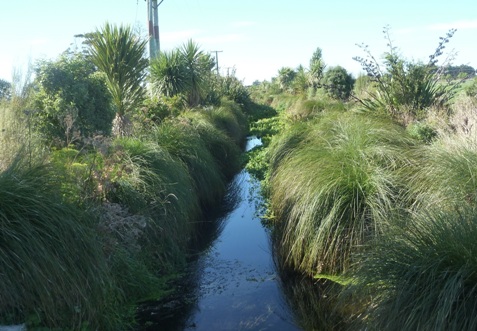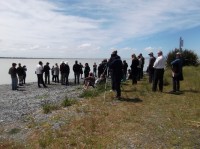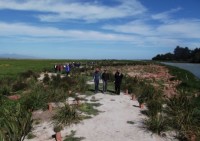Living Lake Symposium 2011
With over 200 registrations, the third Living Lake symposium was the biggest yet! The programme included a series of speakers covering a variety of topics on Tuesday November 15th and Wednesday November 16th. This was followed by a field trip on Saturday 19th November to visit some key sites.
Thanks to our sponsors – Environment Canterbury, Ngai Tahu, NIWA, DOC, Fish & Game NZ, Lincoln University, Selwyn District Council, Canterbury Community Trust, Meridian and Fonterra. Thanks also to the local producers who donated produce or gave us special deals.
The full programme, which includes brief abstracts of the presentations, can be downloaded here.
The slideshows from each of the presenters can also be downloaded – click on the links below.
DAY 1 – TUESDAY NOVEMBER 15th, chaired by Jenny Webster-Brown, Director of the Waterways Centre for Freshwater Research
“Setting the Scene” – Clive Howard-Williams and Ned Norton, NIWA
Land Use Change in Selwyn District – Andrew Mactier, Selwyn District Council
Freshwater fish of Te Waihora – recruitment, important habitats, and changes in fish communities – Don Jellyman, NIWA
Update of surface water hydrology in the Te Waihora /Lake Ellesmere Catchment – Dan Clark, Environment Canterbury
Groundwater resource update and managed aquifer recharge – Howard Williams, Golder Associates
Lake water quality trends and identifying opportunities to make significant improvements – Adrian Meredith, Environment Canterbury
Ecological flows for rivers in the Te Waihora/Lake Ellesmere catchment – Greg Burrell, Golder Associates
Restoration project update 1 – Stephen Brailsford, Part 1 –Waihora Ellesmere Trust, Part 2 – Restoration Activities on Public Conservation Land
Restoration project update 2 – Andrew Spanton, Te Runanga o Ngai Tahu
Restoration project update 3 – Brooke Turner, Te Ara Kakariki
Restoration project update 4– Andrew Mactier, Selwyn District Council
Monitoring and enhancing ecosystem services at Te Waihora/Lake Ellesmere – Steve Wratten, Lincoln University
Whakaora Te Waihora – Donna Woodley, Environment Canterbury
and Jason Arnold, Te Runanga o Ngai Tahu
University research updates Jenny Webster-Brown, Director, Waterways Centre for Freshwater Management
Modelling the water balance of Te Waihora for the National Water Conservation Order amendments – Graeme Horrell, NIWA
Canterbury Lysimeter Network Project – MS Srinivasan, Maurice Duncan, NIWA
The Selwyn River/Waikirikiri – Scott Larned, NIWA
The future of dairying in Selwyn-Waihora – Todd Muller, Fonterra
DAY 2 – WEDNESDAY NOVEMBER 16th, chaired by David Caygill, Environment Canterbury Commissioner
Recap of Day 1 – Ken Taylor, Environment Canterbury & Ken Hughey, Lincoln University
Keynote address: Lake restoration: Is there a successful model? David Hamilton, Bay of Plenty Regional Council Chair in Lake Restoration, University of Waikato
The Canterbury Water Management Strategy regulatory framework – Peter Skelton, Environment Canterbury Commissioner
Water Conservation Order – Craig Pauling and Jason Arnold, Te Runanga o Ngai Tahu
Land Use and Water Quality – Ian Brown, Environment Canterbury and Melissa Robson, AgResearch. Additional notes for this presenatation are also available.
Future proofing through the CWMS – Brett Painter, Environment Canterbury
CWMS Implementation Programmes (ZIPS & RIP): What have we learned so far? – Miria Goodwin and Peter Ramsden, Environment Canterbury
Have your say on Water Management – Selwyn-Waihora Zone Committee present their draft Zone Implementation Programme.
Summary of main themes emerging from both days – Bryan Jenkins, Waterways Centre for Freshwater Management
FIELD TRIP
 Following the two days of presentations, on Saturday 19th November, a field trip visted some key sites around the lake, with a great view from the bus of a number of restoration projects along the way. At our first stop we heard from Phil Garrett, a local dairy farmer who has planted the riparian zones of many drains around his property with native plants. Roger Kilpatrick from Fonterra also shared an industry vision for the catchment.
Following the two days of presentations, on Saturday 19th November, a field trip visted some key sites around the lake, with a great view from the bus of a number of restoration projects along the way. At our first stop we heard from Phil Garrett, a local dairy farmer who has planted the riparian zones of many drains around his property with native plants. Roger Kilpatrick from Fonterra also shared an industry vision for the catchment.
We then moved onto Lakeside Domain and heard about the amazing birdlife from Ken Hughey and about water quality and the macrophyte beds from Tim Davie.
Our final stop was at Lower Selwyn Huts where Stephen Brailsford explained his very successful approach to riparian restoration, and we heard from Robin Smith about key issues for DOC. Robin also showed us the extent of the public conservation land around the lake.


